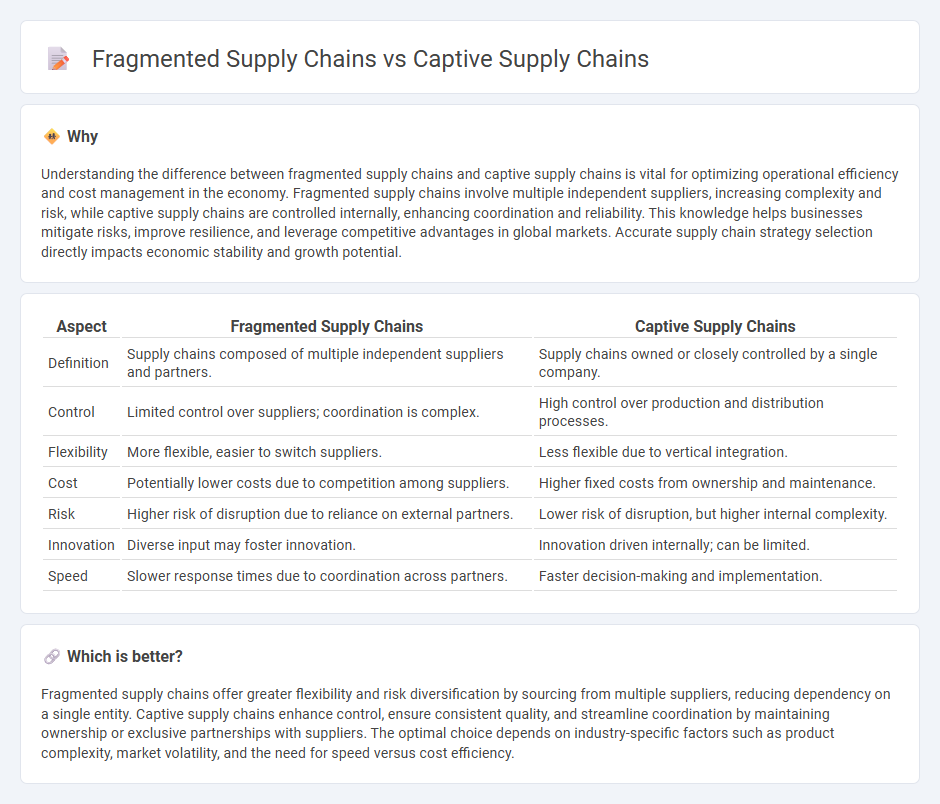
Fragmented supply chains involve multiple independent suppliers spread across various locations, increasing complexity and vulnerability to disruptions. Captive supply chains, by contrast, rely on closely controlled or owned suppliers, offering greater stability and coordination but potentially less flexibility. Explore these supply chain models to understand their impact on economic efficiency and risk management.
Why it is important
Understanding the difference between fragmented supply chains and captive supply chains is vital for optimizing operational efficiency and cost management in the economy. Fragmented supply chains involve multiple independent suppliers, increasing complexity and risk, while captive supply chains are controlled internally, enhancing coordination and reliability. This knowledge helps businesses mitigate risks, improve resilience, and leverage competitive advantages in global markets. Accurate supply chain strategy selection directly impacts economic stability and growth potential.
Comparison Table
| Aspect | Fragmented Supply Chains | Captive Supply Chains |
|---|---|---|
| Definition | Supply chains composed of multiple independent suppliers and partners. | Supply chains owned or closely controlled by a single company. |
| Control | Limited control over suppliers; coordination is complex. | High control over production and distribution processes. |
| Flexibility | More flexible, easier to switch suppliers. | Less flexible due to vertical integration. |
| Cost | Potentially lower costs due to competition among suppliers. | Higher fixed costs from ownership and maintenance. |
| Risk | Higher risk of disruption due to reliance on external partners. | Lower risk of disruption, but higher internal complexity. |
| Innovation | Diverse input may foster innovation. | Innovation driven internally; can be limited. |
| Speed | Slower response times due to coordination across partners. | Faster decision-making and implementation. |
Which is better?
Fragmented supply chains offer greater flexibility and risk diversification by sourcing from multiple suppliers, reducing dependency on a single entity. Captive supply chains enhance control, ensure consistent quality, and streamline coordination by maintaining ownership or exclusive partnerships with suppliers. The optimal choice depends on industry-specific factors such as product complexity, market volatility, and the need for speed versus cost efficiency.
Connection
Fragmented supply chains often rely on multiple independent suppliers, leading companies to create captive supply chains by vertically integrating or forging exclusive partnerships to regain control and reduce risks. Captive supply chains enhance coordination and predictability by consolidating production and inventory management within a single firm or closely aligned entities. This integration reduces the vulnerabilities and inefficiencies inherent in fragmented supply chains, optimizing cost structures and responsiveness.
Key Terms
Control
Captive supply chains offer centralized control, enabling companies to streamline operations, reduce costs, and ensure consistent quality across all processes. Fragmented supply chains, by contrast, involve multiple independent suppliers, increasing complexity and reducing direct oversight, which can lead to variability in performance and higher risks. Explore how mastering control in these supply chain models significantly impacts efficiency and business resilience.
Flexibility
Captive supply chains offer limited flexibility due to centralized control and long-term supplier relationships, while fragmented supply chains enhance adaptability by diversifying sources and enabling rapid response to market changes. Flexibility in fragmented supply chains supports risk mitigation and innovation by leveraging multiple suppliers and decentralized decision-making processes. Explore the advantages and challenges of both models to optimize your supply chain strategy effectively.
Efficiency
Captive supply chains streamline operations by centralizing control and optimizing resource allocation, resulting in higher efficiency and reduced lead times. Fragmented supply chains often face inefficiencies due to lack of coordination, increased risks, and slower response to market changes. Explore further to understand how businesses optimize supply chain models for maximum efficiency.
Source and External Links
Captives can solve supply chain risks: HDI Global | Captive International - Captive insurance entities provide tailored, flexible solutions to supply chain risks that traditional insurance often excludes, such as pandemic disruptions, enabling businesses to cover unique risks and maintain supplier protection amid ongoing global challenges.
Power Imbalance and the Dark Side of the Captive Agri-food Supplier-Buyer Relationships - In agri-food supply chains, "captive" suppliers are highly dependent on a dominant buyer, creating power imbalances that can lead to exploitation and unethical behaviors due to limited alternatives and high switching costs.
Captive supply - Wikipedia - Captive supply refers to stock not owned but controlled by a company, typically seen in industries like meat-packing, where future purchases are agreed upon to maximize profit, linking the concept to supply chain management strategies.
 dowidth.com
dowidth.com